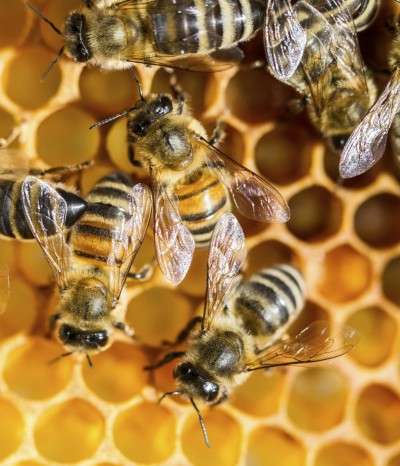Honey bee facility reveals insights into workings of human brain

The honey bee brain is extraordinary. In the same way that the human brain expands in size from birth to adulthood, as we are exposed to experiences, so too does the honey bee brain. It expands to absorb memories, scents, experiences and information increasing in size over spring and summer, and literally shrinks over winter, when there is less sensory overload.
Two new research papers from Monash University researchers reveal the way the honey bee controls aggression and form memories. The discoveries have important implications for the way the human brain controls aggression and forms memories, and loses memory with age.
Honey bees offer great insight into the way the human brain works. For instance, honey bees use memory to find their way back to pollen-laden fields, and they communicate in a sophisticated language to tell other bees about danger and new sources of food.
The importance of the honey bee to neuroscience has led to Monash University opening (beginning of December) a completely unique facility to study the behaviour of bees and what they reveal about the human brain. The advantage of having a honey bee laboratory is that behaviour and brain plasticity can be examined in a controlled manner. Bees emerging from the same brood frame in the hive are exactly the same age, so their exposure to environment of the hive is controlled during the first two weeks of adult development.
The honey bee has a highly evolved insect brain, according to Professor Charles Claudianos, from the Monash Institute of Cognitive and Clinical Neurosciences, who was part of the international team that sequenced the honey bee genome in 2006.
"Honey bees have very streamlined genetics with fewer genes than almost any other species – yet they are highly sophisticated in their behaviour capable of colonial 'loving', hive development, nest cleaning and communication," Professor Claudianos said.
Essentially the lack of gene diversity in the honey bee, combined with highly sophisticated behaviours, means that researchers can better track certain behaviours to specific genes which may have equivalent roles in the human brain.
Professor Claudianos and his team have used a unique way to study behavior in honey bees. The honey bees are trained to stick their proboscis (tongue) out in response to the presence of an odour that is paired with a sugar reward. This behaviour is then positively reinforced with odours such as lavender or linalool (a common floral odour) so that the bee only sticks its proboscis out when there is an aroma "puffed" into its face. The research using this approach has just been published in Nature Communications.
According to Professor Claudianos beekeepers have, for a long time, used lavender to calm bees down prior to harvesting honey.
"Due to our new research we now know why it works as a calmative including for humans and their pets. Our team, colleagues from Australia and France, examined how lavender and other key odours modify honey bees' aggression when they defend their colonies against intruders. The odours counteract the potent alarm pheromones that bees release to recruit nest-mates into defending the hive thus reducing overall aggression," he said.
Specifically, linking the behaviour to molecular changes in the brain, Professor Claudianos and his team have shown that odours such as lavender block aggressive behaviour not by masking the alarm pheromones, but by switching the response off in the brain.
In another collaborative study this time with colleagues in Germany – also published in November in Nature: Scientific Reports – the researchers have shown how the actual chemistry of the honey bee brain dynamically changes via epigenetic mechanisms when memories are laid down. This identification of how memory-based genes are regulated to result in long-term memory has implications for the way dementia appears to affect short and mid-term memories in humans, yet fails to dampen long term memories. These insights are part of the Claudianos Laboratory examining genetic mechanisms that underpin mental health disorders.
Journal information: Nature Communications
Provided by Monash University

















